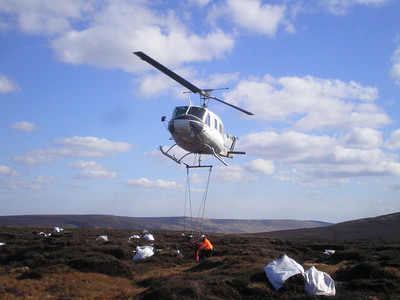Over the 2019/2020 work season alone (which ended slightly earlier than usual this year due to lockdown), the Partnership revegetated over 27 hectares of bare peat by airlifting, and then spreading by hand, over 5,000 bags of cut heather brash and laying down over 13,000 square metres of geo-textile. Heather brash (heather cut from other moors) forms a protective layer over the peat, helping to protect it from further erosion as well as providing a source of seeds that will germinate and help the moors regain a healthy cover of moorland plants. Geo-textile is a landscaping fabric through which seeds and plants can grow through and which is completely biodegradable. The Partnership also planted over a million plugs of sphagnum moss (the crucial bog-building plant), covering over 1,000 hectares.
This works season was one of the Partnership’s biggest ever, with vast amounts of conservation activities taking place. The team also had to contend with working through one of the wettest Februarys on record and then being forced by the coronavirus pandemic to suspend its activities a few weeks early.

In order to help with the revegetation, improve biodiversity, slow the flow of water as a natural flood management mechanism, and increase the wetness of the degraded bogs, the Partnership installed nearly 8,000 mini-dams to block grips and gullies across the moors.
A further way to help improve the overall condition on the moors is to encourage plant diversity, so the Partnership cut over 600 hectares of invasive species.
The Partnership also lay down nearly 1,000 metres of footpaths and rights of way, which was part of the BMC’s Mend Our Mountains project. This work took place on the North America bridleway, which is near to Langsett reservoir. The route forms a smaller circular route with the iconic Cut Gate bridleway, which was a pack horse route across the Pennines and is now a popular mountain biking route.
We need blanket bogs to be in good condition because they provide essential ecosystem services. They trap carbon in the ground helping to fight climate change, they reduce the risk of wildfire, improve water quality, provide natural flood management, and are home to rare and wonderful plants and animals.